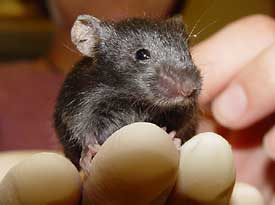Genetically engineered mice created at the Medical School are living every dieter’s dream. They eat unlimited amounts of high-fat mouse chow, but have about 50 percent less body fat than normal mice on a low-fat diet.

And they show no signs of diabetes or other metabolic disorders, which are common in animals with too little fat.
But don’t stock up on potato chips and ice cream just yet. The genetically altered mice are leaner than normal mice, but they also have some less-than-desirable characteristics—such as underdeveloped mammary glands, an inability to generate body heat and skin that’s twice as thick as normal.
All these changes appear to be caused by a protein called Wnt10b, which is present in artificially high amounts in fat tissue from the experimental mice. Wnt10b is one of a family of 19 related proteins. Wnts (pronounced “wints”) regulate the complex changes that take place as an embryo grows. Part of this process is the development of fatty adipose tissue, which contains fat cells called adipocytes.
Ormond MacDougald, associate professor of molecular and integrative physiology in the Medical School, has spent years studying the effects of Wnt10b on the development of adipocytes. In August 2000, MacDougald and his colleagues published a paper in Science, showing that Wnt10b gene activity repressed fat cell development in tissue cultures.
Now, in the first study in living animals, MacDougald and Kenneth Longo, a research fellow in physiology, have demonstrated that Wnt10b has the same effect on fatty tissue in mice.
“High levels of Wnt10b expression produced animals with 50 percent less body fat and fewer fat cells, regardless of whether the mice ate a high-fat or low-fat diet,” MacDougald says.
Results of the experiments were posted last month on the Journal of Biological Chemistry’s JBC Online Web site.
“To determine the effect of the gene on adipose tissue development, we created an artificial sequence of DNA called a transgene linking Wnt10b to another gene called the FABP4 promoter, which is expressed only in adipose tissue,” Longo says. “We injected the transgene DNA into fertilized mouse eggs and bred mice that inherited the new gene to create the animals used in our study. Under the control of the FABP4 promoter, fatty tissue in the transgenic mice contained 50 times the amount of Wnt10b found in adipose tissue from normal mice.”
Longo and MacDougald discovered that Wnt10b had a different effect on the two types of fat found in normal mice. White fat is a storage reservoir for excess energy. Brown fat is a specialized form of adipose tissue, found in small mammals and human newborns, which generates heat to keep the animal warm. While the transgenic mice in the U-M study had half as much white fat as normal mice, they had virtually no brown fat. This made it impossible for them to maintain their core body temperature, leaving them vulnerable to cold.
For reasons U-M scientists don’t understand, the transgenic mice had skin that was twice as thick and much heavier than normal mice. Another puzzling and unexpected finding from the study was that the transgenic mice consumed slightly less oxygen.
But perhaps the most surprising thing about the transgenic mice was their general state of robust good health.
“When we started making these animals, we thought they would have reduced amounts of fat, and thus suffer from metabolic complications, including diabetes,” Longo says.
“In fact, the insulin sensitivity and glucose tolerance of transgenic mice on a high-fat diet was better than that of normal mice on a low-fat diet. We don’t know why, but additional research should provide some answers,” MacDougald says.
But don’t look for Wnt10b diet pills to be on the market any time soon, caution Longo and MacDougald.
“Pharmaceutical companies are interested in the potential therapeutic role of Wnt genes in decreasing fatty tissue, but finding the right drug to selectively target this pathway without complications will be a considerable challenge,” MacDougald says.
“We’ve seen the potent effect of Wnt10b on fat in mice, but we don’t know if it would work the same way in humans,” Longo adds. “And, if the results we see in the skin of the transgenic mice are any indication, I’d say we have to tread carefully. I think we’d all like to be thicker-skinned, but only in the figurative sense.”
The research was funded by the National Institutes of Health, the U-M Center for Integrative Genomics, the U-M Center for Organogenesis, the Diabetes Research and Training Center, and the American Diabetes Association.
The experimental mice used in the study were produced in U-M’s Transgenic Animal Model Core facility. The University has filed for patent protection on the Wnt10b transgenic mouse.
Study collaborators from U-M included Wendy Wright, research associate; Sona Kang, graduate student; Isabelle Gerin and Shian-Huey Chiang, post-doctoral fellows; Dr. Peter Lucas, lecturer in pathology; and Mark Opp, associate professor of anesthesiology and of molecular and integrative physiology.

